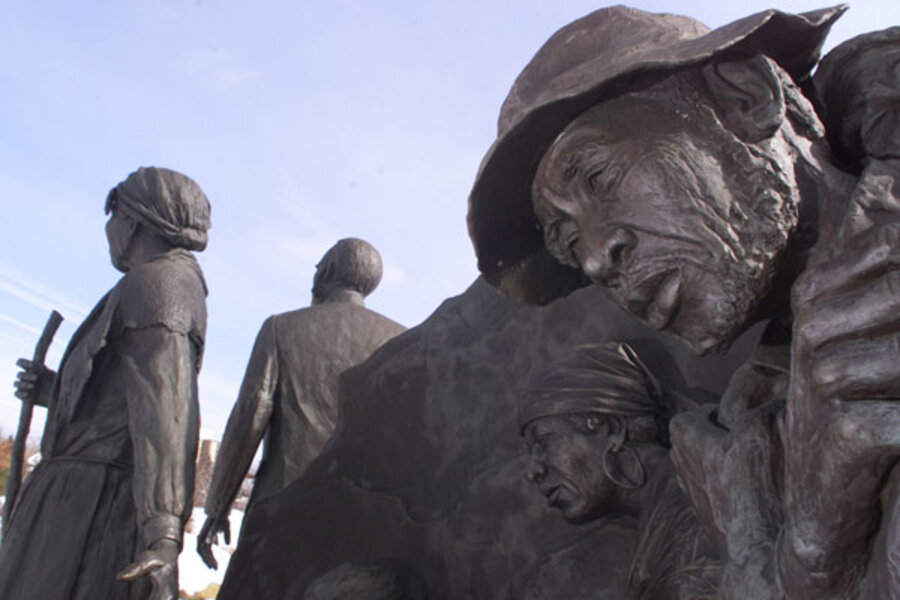Obama to push Harriet Tubman site closer to becoming national park
Loading...
Swamps along the Eastern Shore of Maryland and a modest house in Wilberforce, Ohio, may not look like much – until they’re seen through the lens of history.
The Harriet Tubman Underground Railroad National Monument in Maryland and the Charles Young Buffalo Soldiers National Monument in Ohio are among the five places expected to be designated as national monuments by President Obama on Monday. Both will shed new light on African-Americans’ contributions to the American story.
The Charles Young monument, which includes one of his homes, recognizes the famous leader of segregated black Army regiments during the late 1800s and early 1900s. Colonel Young was the third African-American cadet to graduate from West Point and be commissioned as an Army officer. He served in the American West and around the world and later became a professor at Wilberforce University, according to the website of the National Park Service.
“It’s really a significant step that the president is taking: Designating that as a national monument really protects that home … and preserves an important part of American history,” says Charles Wash, director of the National Afro-American Museum & Cultural Center in Wilberforce.
The two-story home is currently in disrepair and hasn’t been open to the public for years, Mr. Wash says. Young’s fraternity, Omega Psi Phi, has offered it to the government. Passers by can read a plaque on a boulder in front of the house that the museum imported from Sequoia National Park. Young and his troops spent the summer of 1903 clearing and extending a road there – accomplishing more in one summer than others had done over the previous three summers, according to the National Park Service.
Young “was more than just a soldier, he was a renaissance man,” Wash says.
Young maintained friendships with two other famous figures, W.E.B. Du Bois and Booker T. Washington. From his manuscripts it’s clear that “he often put the good of the country above racial issues,” Wash says. He turned down an offer to lead the NAACP because he wanted to continue to serve in the military during World War I, he adds.
The Harriet Tubman monument in Maryland will help people imagine what it must have been like for the famous abolitionist to flee slavery in 1849. Tubman was born on Maryland's Eastern Shore and escaped slavery by wading through the swamps, eventually reaching Philadelphia. She would return 13 times to free her family and others, according to the Conservation Fund, which has donated a 480-acre property adjacent to Blackwater National Wildlife Refuge for the monument.
The property includes the former home site of Jacob Jackson, a free black who helped Tubman rescue family members.
Tubman served in the Union Army during the Civil War, led the Underground Railroad, and went on to advocate for civil rights and women’s rights.
“Journeys along the Underground Railroad were a dangerous scramble across wilderness and through populated areas, and success required heroes like Harriet Tubman to know the land, travel swiftly, and repeatedly take risks,” wrote Bill Crouch, the Conservation Fund’s Maryland director, in an e-mail to the Monitor. The Fund, he wrote, “is thrilled to honor Tubman’s heroism” and thankful to the president, Interior Secretary Ken Salazar, the governor of Maryland, and “all the others who have worked for years to preserve these lands.”
As national monuments – which the president has the authority to name under the Antiquities Act of 1906 – the sites would be managed by the National Park Service and could still be designated in the future as national parks.
Indeed, efforts to establish a national park to honor Harriet Tubman have been supported in recent years by US senators from Maryland and New York, as well as civil rights and women’s groups.
“Harriet Tubman was a courageous fighter, and tireless in her commitment to fight for those who could not fight for themselves. Designating a national monument is an important step as we move towards the establishment of National Historic Parks to commemorate her heroic works,” Sen. Barbara Mikulski (D) of Maryland said in a statement Friday.
Out of 80,000 sites on the National Register of Historic Places (which includes national monuments), only 3 percent focus on the stories of minorities and women, according to a 2012 press release from Senator Mikulski’s office.
The other sites to be announced by Mr. Obama Monday are Río Grande del Norte National Monument in New Mexico, First State National Monument in Delaware, and San Juan Islands National Monument in Washington State.
The 1,100-acre Delaware site is the first step toward creating a national park in Delaware, the only state without a national park, the Associated Press reports.







